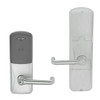Product Description
AD200-CY-70-MT-TLR-PD-619 Schlage Standalone Cylindrical Classroom/Storeroom Multi-Technology Lock with Tubular Lever in Satin Nickel Finish
The Schlage AD200-CY-70-MT-TLR-PD-619 series of standalone electronic locks provides higher facility and security of rights on the lock. Standalone electronic locks series has an ANSI/BHMA A156.25, Grade 1 certified and UL 294 listed. It is a simple, economical solution if no access control system currently exists in a facility, or for openings that don't require the control of a networked solution and these series is ideal for small to medium size applications and it is easily upgradable to a networked lock if requirements change in the future. These modular design allows the lock to be customized to fit the needs of an application and can change to meet future needs without removing it from the door.
The Handheld device (HHD) used in conjunction with your access control software, allows you to easily add or delete users and retrieve audits.
Features and Benefits:
- Satin Nickel finish
- Tubular lever style
- Door thickness: 1-3/4" standard
- 4AA battery kit included
- The ability to upgrade to a networked solution without removing the lock from the door
- Strike plate: 1-3/16" lip, ANSI, no box, 1-1/14" x 4-7/8"
- Audit trail reports that allow you to track usage and events
- Backset and latchbolt: 2-3/4" backset, deadlatch, square corner, 1-1/8" x 2-1/4"
- Bored lock installed into a round hole in door
- Standard keys are included
- Everest 29 S123, 6 pin key in lever Full Cylinder
- Single solution that reads 125 kHz proximity and 13.56 MHz smart credentials
- Compatible with major brands of master key systems and exit devices
- Update users and access rights at the lock using the keypad or handheld device
- Valid toggle credentials on the exterior may be used to change to a passage or secured status.
- Handheld device (HHD) is not included
- Lockset is normally secure. Inside lever always allows free egress
- Security that's more intelligent and convenient than traditional mechanical locking devices












